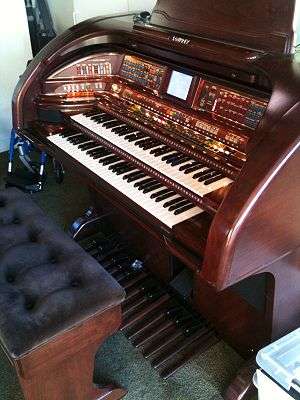Lowrey organ

_stop_knobs_-_spotted_at_the_Pine_AZ_Thrift_Store_(2011-06-17_10.14.36_%40pxhere_223605).jpg)
.jpg)

The Lowrey organ is an electronic organ named for its developer, Frederick Lowrey, a Chicago-based industrialist and entrepreneur.[2]
During the 1960s and 1970s, Lowrey was the largest manufacturer of electronic organs in the world.[2] In 1989, the Lowrey Organ Company produced its 1,000,000th organ.[3] Up until 2011, modern Lowrey organs were built in LaGrange Park, Illinois. In 2011, it was announced that production of a few models was to be moved to Indonesia. Lowrey brand owner Kawai Musical Instruments announced in October 2018 that production would cease in January 2019.
Most notably, the Lowrey organ differs from the Hammond organ (which also bears the name of its Chicago-based inventor) in its incorporation of "automatic accompaniment" features. While originally intended for the home entertainment market, it was also used by some rock groups in the 1960s and 1970s. Garth Hudson, the keyboardist of The Band, played a Lowrey Festival organ on many of the group's most notable songs.[4] Its sound can be heard prominently on the 1968 recording of "Chest Fever", which begins with a Bach-inspired prelude/intro.[5] The Lowrey Organ is one of several organs on The Beatles' 1967 song "Being for the Benefit of Mr. Kite!" (from the Sgt. Pepper's Lonely Hearts Club Band album), helping create a fairground atmosphere.[6] Furthermore, a Lowrey DSO Heritage organ was used to produce the classic opening for "Lucy in the Sky with Diamonds". [7]
The Lowrey Organ and its build-in drum patterns are also heard on the million-seller single, "Why Can't We Live Together" of Timmy Thomas.
A rather surprising use of a Lowrey Organ, on a percussive "marimba repeat" setting, was the synthesizer-like background noise on The Who song "Baba O'Riley".[8] Mike Ratledge of Soft Machine switched from a Vox Continental to a Lowrey Holiday Deluxe[1] sometime between late 1966 and early 1967, and used it from then on, adding a fuzzbox and plugging it into a Marshall stack. To prevent feedback in the silences between notes (consequence of playing at a very high volume), Ratledge invented a style of his own avoiding the between-note gaps by soloing in legato. Mike Oldfield made use of the instrument quite extensively on his Tubular Bells album, and on several later albums as well. The Gotye song State of the Art was written to showcase the sounds of the Lowrey Cotillion model D-575.[9]
From 1966 to 1971, Lowrey also produced combo organs for Gibson while the guitar manufacturer was owned by parent company Chicago Musical Instruments. The most popular of these was first introduced in 1966 as the Kalamazoo K-101, but was renamed the Gibson G-101 shortly thereafter. The Gibson branded organs' design and circuitry were similarly based on Lowrey's own "T-1" and "T-2" models, as well as their "TLO-R" and "Holiday" spinet models. However, they had several additional features that made their sound distinctive from other Lowrey models, including "Repeat", "Glide", and "Trumpet Wow-wow" effects.
References
- 1 2
Frank Pugno, Bil Curry (2005-11-03). "LOWREY ORGANS". Electronic Organs (theatreorgans.com/hammond/keng/kenhtml/electronicorgans.htm). VintageHammond.Com.
"In 1956, the Glide, a foot switch located on the left side of the expression pedal, was introduced, permitting the effects of a Hawaiian guitar “glide”, the smear of a trombone, the glissando of singing strings and the effect of a calliope. The Glide dropped the pitch of the organ about a semi-tone and cancelled the vibrato. / In 1961, Lowrey’s first home organ with a built-in Leslie speaker appeared as the Holiday Deluxe Model LSL. Automatic Orchestra Control, later renamed Automatic Organ Computer, came on the scene in 1963. / Fig. 2 – Holiday Deluxe Model LSL"
- 1 2 "History of tradename". Musical Instrument Technicians Association. 2007. Archived from the original on 2007-07-04. Retrieved 2009-07-27.
- ↑ "Music Trades". 1989-07-01. Archived from the original on September 3, 2009. Retrieved 2008-07-20.
- ↑ Doerschuk, Bob (December 1983). "Garth Hudson: Legendary Organist with '60s Supergroup 'The Band'". Keyboard Magazine.
- ↑ Johnson, Brian D. (July 22, 2002). "Garth Hudson (Profile)". Maclean's.
- ↑ Lewisohn, Mark (1988). The Beatles Recording Sessions. New York: Harmony Books.
- ↑ Babiuk, Andy (2001). Beatles Gear. San Francisco: BackBeat Books.
- ↑ "Lowrey Berkshire Deluxe TBO-1 organ: Baba O'Riley/Won't Get Fooled Again 'synthesizer' sound". Whotabs. 27 August 2005. Retrieved 14 September 2010.
- ↑ "Planet Gear: Gotye on the Lowrey Cotillion organ and Making Mirrors". Drowned in Sound. 4 January 2012. Retrieved 13 November 2017.
External links
| Wikimedia Commons has media related to Lowrey Organ. |